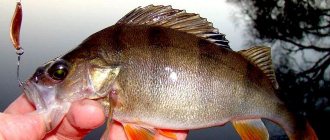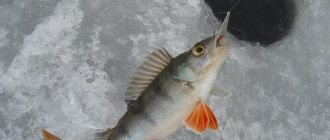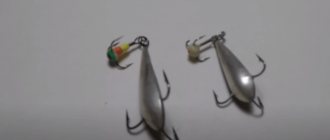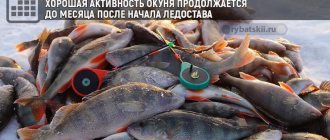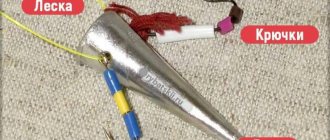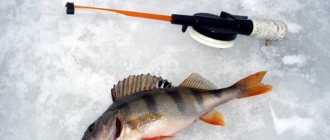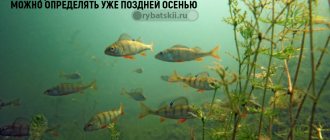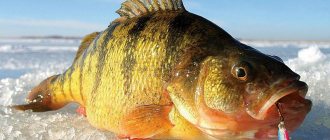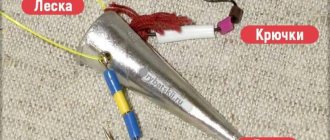This method of catching a striped predator, like catching perch in winter with a spinner, has its own characteristics and subtleties, which you will learn about from this article. For some reason, such fishing is considered less successful than fishing with a jig. It seems that if a perch is caught, it will grab any metal bait, especially if it also has bloodworms. Many also believe that a spoon is necessary only in cases where it is not possible to buy bloodworms and that this type of fishing requires certain skills and abilities.
This opinion is quite erroneous. Perch is a schooling predator and the basis of its diet is fry, which can be imitated with a spinner or a balancer. And if I’ve already talked about catching perch with a balance beam, now it’s time to talk in more detail about how to catch perch with a spoon in the winter.
Other fish in the cold season reduce their mobility and react poorly to bait. In contrast, perch remains active even in the most severe frosts. In this regard, it is he who is often the main target of anglers.
Winter fishing for perch with a spoon is one of the most effective techniques. With the correct determination of the place and time of fishing, the right choice of gear and bait, it will not only allow you to have a pleasant and exciting time, but also return home with an impressive catch.
Time and place of fishing
Catching perch in winter is more difficult than in summer. By the time ice forms, the fish gather in schools and move to the depths for the winter. You should look for the striped predator near steep banks, dams, and in holes with flooded trees. Smaller perch can be found in the reeds: there they look for food.
Experienced fishermen claim that you can catch perch everywhere in the cold season. This predator leads an active lifestyle and therefore moves throughout the reservoir in search of food. It can be found both at considerable depth and in reeds or on small shallows. In this regard, you should not bypass the favorite places for catching this type of fish in spring or summer.
In addition to choosing a site for perch fishing, you need to pay attention to the weather. The predator is most active when the first ice appears. At this time, he looks for food throughout the reservoir, but with the onset of severe frosts he goes to the depths.
Perch is most active in sunny weather. If the sky is overcast and snowing, you won’t be able to achieve results even with the best equipment. In this case, temperature does not play a role - this type of fish bites well both in severe frost and in thaw, if the day is clear.
Choosing a place for winter fishing for perch with spoons
Correctly choosing a place for winter perch fishing directly affects the effectiveness of fishing. This is explained by the fact that during certain periods the behavior of the fish changes, which affects the intensity of the bite. Thus, after the appearance of stable ice cover at the beginning of winter, perch is still active, and therefore can be found in any part of the reservoir (Figure 2).
Note: Experienced fishermen advise starting drilling holes from the coastal zone, in places where underwater vegetation, snags and piles of stones accumulate, where perch can hunt for fry. With the onset of severe frosts, when the ice becomes thicker, the fish move to deeper parts of the reservoir, where the water is saturated with oxygen.
Therefore, you need to look for perch in holes with a clean bottom of underwater riverbeds and streams with weak currents, as well as at depths near spits. There the fish stays at the very bottom, at a depth of 4 to 6 meters. At the end of winter, in preparation for spawning, perch begins to actively feed, moving to places where fry gather. You need to look for it at the confluence of streams and in melt water drains. Experienced fishermen advise catching perch in the winter in the morning, at an air temperature of at least -15 degrees and stable atmospheric pressure. Therefore, it is best to choose a calm, not too frosty day for fishing. In mild cold weather, the fish sticks to edges, old riverbeds, and shallows, preferring the crustacean or hard bottom. At lower temperatures, predators are searched for in deep holes and pools.
It will be useful to listen to the following advice from experienced fishermen:
- Schools of small perch love to hunt in shallow water, and if these areas border holes or depressions, then the likelihood of successful fishing increases.
- If you have a choice, it is better to drill holes in places marked by thickets of reeds, branches frozen in ice or objects of artificial origin.
- Perch is always caught in areas with a hard, sandy bottom.
Figure 2. Choosing the right fishing location plays a key role in the success of the fishery.
When fishing in shallow waters, where the water thickness is 20 cm, you can also count on a catch, since such places attract small fish, after which perch can come.
Tactics and fishing techniques
After the ice gets stronger, the activity of the predator decreases somewhat, and here the fishing tactics come down to searching for perch. Having found the expected location of the fish, we make several holes at a distance of several meters from each other and start fishing. The technique for winter trolling for perch is as follows: first, lower the lure to the very bottom, then lift it and make several short strokes, alternating them with pauses. Some people wave their fishing rod too widely. This should not be done; for a bait 2-3 cm long, especially at shallow depths, the amplitude of the swing should not be more than 10 cm.
If there are no bites, try moving the bait a little higher, and gradually move closer to the surface. Having fished a hole and not finding fish in it, immediately move to another without wasting time.
However, many anglers adhere to slightly different tactics for catching perch in winter using lures. They use bait, which attracts small fish, after which the perch goes to the hole. The method is quite simple, but effective.
Also, twitching the bait up and down, when the spoon quickly rises and falls, can attract the attention of a predator. By loosening the fishing line, you can achieve oscillatory movements, and a slow lift with uniform acceleration often makes the perch rush in pursuit.
At times, the perch seems to begin to mock the angler - empty bites follow one after another. The predator plays with the bait, but there is still no decisive bite. In this case, you can try putting a bloodworm on the hook of a spoon or wrap the hook with red thread.
Nod and ways to play
Avid fishermen will agree that without using a nod, winter fishing will become much more difficult.
Since it will not be possible to sensitively sense a weak bite and make the game with bait more varied. One of the most popular ways of playing is applied to nipple nods, and is carried out in the following way:
First, the depth is measured and the gear is properly adjusted, after which the spoon is placed on the bottom.
After this, we lift the spoon with a smooth movement so that the hook remains touching the bottom. To do this, you need to watch the nod, and if the spoon comes off the bottom, the guard will bend greatly.
All this manipulation must be done with a well-fixed hand.
Ÿ We repeat the movements according to the following scheme:
- Swing
- Spinner on the bottom
- One second pause
- Raising the spoon
- Pause 3-4 seconds
- Swing
If such a game is played in the same way and methodically, then even the most passive perch, unable to bear it, rushes to the bait.
The advantage of nipple nods is their elasticity, which allows you to achieve small jerks, literally at a guard distance. Thus, the spoon practically does not move, but attracts a lot of attention.
Due to excellent shock absorption when the fishing line is taut, the spoon bounces well at depth, which also attracts the “striped predator”
Another advantage of nipple nods is the fact that an ordinary game can be made more diverse. To do this, it is enough to make smooth rotational movements with your hand in different directions.
Depending on the use of the nod and the type of spinner, there are several more game options:
Active play with a spinner in order to attract a distant perch. First, the spinner rises and falls several times, and then the game begins with small spinners.
The spoon rises from the ground with short and jerky movements. There should be a pause of one second between jerks.
The game is designed to use a soft nod. The spoon is raised so that the hook touches the bottom. With quick but very short movements we create vibration of the spinner.
Smoothly raising and lowering the rod, sharply hit it with the other hand. The spoon suddenly becomes unbalanced, creating vibrating movements. Sometimes this method is very effective when other games do not help.
If the depth is very small, approximately 25-30 cm, then you can do the following. The spoon periodically rises to the very surface of the water, and then sinks to the bottom again.
We looked at the most common and interesting aspects of winter fishing. By taking them into account, you are guaranteed a great time and a great catch.
Tackle
Gear for catching perch with lures in winter is selected in accordance with the size of the expected trophy and the weight of the bait used. Fishing rod handles should be made of so-called “warm” materials. These are cork, foam plastic, wood, neoprene, EVA. They warm your hands in cold weather and are not afraid of water. The length of the fishing rod usually does not exceed half a meter, then everything depends on the needs and preferences of the fisherman. The whip can be carbon or plastic.
The coil is usually not used. It is not involved in landing fish and is used only for winding and transporting fishing line. At the same time, due to the constant throwing of the fishing rod onto the ice, it will deteriorate and sooner or later break.
More important is the nod (or guard). This is a special device that performs a number of functions:
- warning about the beginning of a bite;
- assistance in controlling the movement of bait in the water;
- attracting the attention of perch (or other fish) by improving the performance of the bait.
Reporting a bite is the main purpose of the nod. This part is attached to the end of a winter fishing rod and is highly sensitive, so the fisherman knows even a slight touch to the bait. This is important, because in winter the fish are passive and inactive, so they can stay near the bait for a long time without touching it.
Depending on the presence of a nod, fishing rods are available with nods and nods.
Nodding fishing rod
To catch perch in winter using a spinner, a soft nod is used. It will not make false swings and disrupt the action of the bait. Fishermen buy metal or lavsan guards or make them themselves. It is important that under the weight of the bait the nod bends almost completely and does not spring back in the opposite direction. When biting on the rise, it straightens.
If heavy baits are used for fishing in winter, it is recommended to equip the fishing rod with a guard. He will report even the slightest touch to the bait and will not allow you to miss even the most careful bite.
Kickless fishing rod
Light, no-kick fishing rods are popular when fishing for perch in winter. Their key feature is that they are so light in weight that even the most accurate bites can be easily felt by the hand.
According to experienced fishermen, such gear is effective in winter only when fishing for actively behaving fish. A sedentary fish may peck so carefully that it is easy to miss. Therefore, it is recommended to equip these fishing rods with a soft nod.
Posting a vertical perch spoon
First, let's estimate what can happen to a winter vertical perch spoon after too long a top retrieve, which is also called a “toss.”
Although I don’t quite understand how you can throw something in the water. Then, rather, quickly stretch it out, tying it to something.
And the essence of the CORRECT upper and lower wiring of a perch vertical gliding spoon lies in the following simple equality.
The rise of the bait on the top wire should be equal to the length of the free gliding path of the spoon, at the end of which the bait should reduce its speed to zero.
Let me explain how this method of fishing or tactics for catching perch with a vertical spoon should look like in practice.
Let’s say that when catching perch in a winter pond at a depth of 4 meters, we “threw” a vertical spoon 70 centimeters, then sharply threw the whip of the winter fishing rod down. At the same time, coils of discarded fishing line will appear on the surface of the water in the hole, the length of which will also be 70 centimeters.
And, if we catch perch with a winter spinner, characterized by an almost vertical retrieve, then it costs nothing for the bait to take out the entire supply of discarded fishing line and freeze after fading oscillations at a resting point under the hole.
A winter spinner for catching perch with a clearly defined vertical line is shown in the photo in the left position. The advantages of “stud” spinners are discussed in detail on one of the previous pages of the topic.
And here I offer interested fishermen to download free material, on the preparation of which a lot of time was spent - I give a link to the archive with drawings of my vertical winter homemade lures for perch.
Reaction of the nod to the posting of a perch spoon
The main disadvantage of spinners is their poor planning in the horizontal plane and the speed gained on the steep section of the retrieve is too high, which causes the nod spring to play out in the upper direction.
When guiding the perch spoon, shown in the photo on the right, the bait during the wiring process will select all the dropped fishing line and at the final point of planning will reduce the speed to zero - with the correct chosen height of the spoon drop. Then the reaction of the nod spring at the end of the end of the perch vertical bait will be minimal.
Typically, narrow vertical winter lures are used to catch perch at depth among snags, especially if the winter fishing rod is equipped with a thick line. For such spinners in real perch fishing conditions, I suggest two main methods of retrieving.
fishing line
For winter perch fishing, it is best to use monofilament fishing line. Wicker is less comfortable. Thickness – from 0.1 to 0.2 mm, depending on the size of the spoon. If the length of the latter is from 2 to 2.5 cm, a thin fishing line with a diameter of 0.1 to 0.12 mm is good. The bait will show its best game on it. If the spinner is longer and thicker, then the fishing line should match it.
If you plan to fish in the shallows, you need to wrap 10 to 15 meters of fishing line on a reel or rod. If you plan to fish at great depths, the length should be increased to 20-25 meters.
The best winter perch spoons
All beginners purposefully search for the most catchy winter lures for perch. Experienced fishermen know that there is no absolute coolest bait. In different conditions, you need to change options, select a worker in specific situations. There are a huge number of types of perch spoons, and all of them are catchy in certain conditions. Therefore, an ice fisherman needs to have a set of spinners of various shapes, weights, sizes, colors and equipment for winter fishing for perch, using them depending on the preferences of the fish.
Spinner attachment methods
When buying a spinner, it is better to choose a bait with a soldered metal ring for the fishing line. You can drill a hole yourself, but regardless of the grinding method, the fishing line will constantly fray, so it will have to be tied again. The ring will allow you to avoid this.
The fishing line is attached to the lure in two ways - with a rigid knot or a fishing clasp. The second option is more preferable. It allows the bait to constantly remain in one position and show its best game, and also helps to avoid chafing of the line if the hole in the spoon is drilled by hand.
The first method of fastening also allows you to use the spoon as efficiently as possible, but it has one caveat - in the process of landing a perch or removing a fish from a hook, the knot periodically gets knocked down, after which it becomes noticeable that the bait behaves differently, and there are fewer bites. This means that it will have to be constantly checked.
Winter lures for perch
When choosing spinners for winter perch fishing, you need to take into account their characteristics. The material of manufacture does not matter, but you need to pay attention to the color of the bait. On a clear day, it is better to choose copper or brass-colored spoons, and on a cloudy day, silver ones.
Lure size
The size of the spoon is selected taking into account the dimensions of the expected catch. When catching small perches, a bait of up to 2 cm in size is enough, for a medium size - from 3 to 5 cm. To catch a large fish, you need to choose a spoon from 5 to 10 cm, and if the reservoir is deep, then from 8 to 10 cm.
What should the hook be like?
According to the type of fastening, there are the following types of hooks:
- spinners soldered into the body;
- suspended through a ring;
- suspended on a chain.
If you are using small or medium-sized spoons, it is better to choose single hooks. They will not upset the balance of the bait and will not spoil its performance. In addition, such a hook is much easier to remove than a double or triple hook, which means there is less chance of missing an approaching school of fish. Double or triple hooks are used for large spoons when hoping to catch a big trophy.
When choosing a mounting method, it is recommended to be guided by the behavior of the perch:
- active bite - soldered hook;
- flaccid - suspended on a ring;
- lack of activity - hooks on chains.
It is important that the hook, after attaching it to the spoon, does not protrude beyond its edges by more than 2 mm. Violation of this rule will lead to idle bites.
Center of gravity of the spinner
When choosing a bait, its center of gravity plays an important role. There are the following types of spinners according to this indicator:
- Lower center of gravity. The best solution for spinners. Such baits are lowered into the water vertically and at an angle from the hole, play actively and create large vibrations. Having landed, they raise silt from the bottom and thereby additionally attract perch.
- Average center of gravity. The spoon falls horizontally, is well balanced and plays with its side edges when diving.
- Upper center of gravity. A rare bait option. Relevant when fishing for perch with passive behavior, because behaves specifically when diving to the bottom. He makes a somersault and thereby attracts the attention of the fish.
Thus, the choice of center of gravity depends on the behavior of the fish. Most often, a spinner is used with its lower placement.
Gliding or vertical spinners
Winter lures for perch are divided into two types: vertical and gliding.
Gliding lures are effective in shallow water, in still water, when the fisherman manages to find a school of perch that is actively searching for food. They descend into the water with a deflection and show an active game, attracting the attention of fish from a long distance and gathering it to the hole.
Vertical or “studs” are effective during the period when the perch behaves passively. They sink into the water, practically without deviating from the vertical. Such spoons are heavier and narrower than those that are gliding. They give good results at great depths, in bodies of water with currents, and in places with flooded snags.
When going fishing in winter, it is better to take several types of spinners in order to be prepared for any behavior of the perch and be able to catch the striped predator in different places in the reservoir.
Catching perch with lures in winter and what you need to know
A predator of freshwater bodies of water, perch, remains active throughout the year. This representative of the underwater world does not fall into suspended animation or hibernation during the cold season, and therefore attracts the attention of winter fishing enthusiasts. In addition, the process of fishing with a spoon is good because of its speed; it is not only done quickly, but also guarantees an excellent result without fear of breaking the gear (Figure 1).
Note: Since perch is a schooling fish species, it becomes possible to catch a large number of fish in a short period of time using the trolling technique. A good fishing result depends on the fisherman’s ability to choose the right fishing line and the weight of the spoon so that the bait sinks correctly into the water without scaring away the perches.
Using spinners allows you to forget about purchasing any additional attachments, such as bloodworms, and also eliminates all the inconveniences associated with stringing bait in the cold. Since the spoon has the appearance of a live fish, it is able to attract large specimens, while small ones will remain indifferent to it, which will undoubtedly please the fisherman. At the same time, the use of spinners requires special skills that allow you to play correctly, because a careless swing of the fishing rod can scare away the fish.
Figure 1. Flashing a perch is a very exciting activity.
In addition, trolling is a fairly active activity that requires constant movement around the reservoir and handling gear, which may not be possible for some people with health problems. So, during winter perch fishing, a fisherman can travel a distance of 10-15 km along a reservoir. That is why this method of winter fishing has both its supporters and opponents.
Types of winter lures for perch
There are a large number of spinners for catching perch in winter, both factory-made and homemade. The most effective in different conditions are the following types:
- carnation;
- boat;
- petal;
- crucian carp;
- whitebait;
- Ray;
- diamond;
- column;
- torpedo;
- triangular;
- half;
- sleeper, etc.
The difference between them is not only in form, but also in their unique, inimitable game. It is recommended to try most of them to evaluate their convenience and effectiveness and choose the optimal lures for yourself.
Equipment for catching perch in winter with a spinner
The success of fishing depends not only on a well-chosen place, but also on correctly executed equipment (Figure 3).
Fishing for perch in winter will be successful if you have the following gear:
- A thin, non-rigid and flexible fishing rod, more than 10-15 cm long, equipped with a reel.
- The reel can be the simplest, inertia-free, so that it is convenient to carry out fishing. You can also use a reel.
- But the fishing line will need to be as thin as possible in order to give the tackle sensitivity and to play the lure more accurately. In addition, coarse fishing line is clearly visible in the water in winter, so a predator may simply not approach it. Its diameter depends on the expected size of the perch and usually ranges from 0.12 to 0.20 mm.
- It is better to use a medium-hard cone-shaped nod made of polycarbonate or metal, as well as lavas and corporal - materials that have the ability to resist cross winds. The length of the nod should be up to 10 cm. In addition, it should bend slightly under the weight of the bait. So, with a working length of 5-6 cm, the bending angle under the weight of the bait should be no more than 30°. This will ensure good play with the bait.
Figure 3. Necessary gear for winter fishing
Using a hanging hook
A suspended hook works effectively in conjunction with conventional baits and significantly increases the chances of success when catching perch in the cold season, especially if the fish has a passive behavior.
The peculiarity of the design is that a freely moving hook of 16-18 numbers is put on a thin fishing line (0.08-0.10 mm) with the tip up. It should be lighter than the main bait. Then a jig is tied for the perch. Additionally, beads, beads or cambric are attached to the hook. As a result, there are several baits on one line that can interest predatory fish. One bait is completely controlled by the fisherman, and the second independently moves up and down along the line, thereby explaining its second name - “catch-up”.
Any winter fishing rod is suitable for fishing with a hanging hook. The nod should be rigid, with a minimum bending angle.
Retrofitting the spinner
To be guaranteed to attract the attention of a perch during winter fishing, it is worth equipping the spoon with additional stimuli. To do this, the hooks or hanging tees of the bait are decorated with beads, fibers or cambrics. The striped predator loves red, as well as brown and green colors, reminiscent of underwater insects or crustaceans. Yellow, blue and orange colors often produce the effect.
A little higher, above the spinner, you can place another provocateur - a fly or a bully (imitation of a whitebait). They can be sliding or firmly fixed on a retractable leash.
Spinner baits with suspended irritants can be equipped with hooks with fibers (bloodworms, beads) or a short leash made of fishing line or chain with a fixed fly.
Foreign decoys
As an example of the best foreign-made lures for perch for winter fishing, I can cite the following.
- Smith Pure. It is one of the clear leaders among oscillating lures for perch.
- Rapala SM-Pirken. The best option for fishing in the dead of winter.
- Rapala Minnow Spoon. A universal bait that is suitable for beginners and for cases when you simply don’t know what else to try.
- Nils Master Hanski. The bait is interesting in its design; it has a small chain on which a tee is attached. Therefore, if necessary, it can be quickly replaced.
- Nils Master Snub-Head. Also an option with a tee on a chain, but differs from the previous spinner in its cone-shaped shape. The tees are covered with a special luminous composition, which additionally attracts perch and is most often an area for attack. Those. In fact, the fish rushes to the tee and is caught itself.
- Nils Master Dueler. At the moment of retrieving, it makes a slight vibration, which does not remain invisible to the perch.
- Kuusamo Leija. It is equipped with additional blades, due to which it shows a natural game and can make turns.
- Kuusamo Kilpa-Loiste. A small-sized bait that is perfect for catching perch. It has a special reflective film, which only adds to its effectiveness.
- Kuusamo Sinfonia. Used in areas where there is no current, it glides during play, creating an original acoustic effect.
- Rapala Arkku ARK 70 SG. Capable of showing good play both in still water and in the current.
- Hali Lindroos Luxus. The bait has a textured surface, which allows a predator to easily detect it.
- Kalamies 6 Hop-Mes. Heavy lure designed for fishing at great depths, up to 8-10 meters.
- Captain. The Finnish-made spinner “Captain” makes random short jerks when reeling, and when it touches the bottom, it begins circular movements.
- Nautilus. Another catchy Finnish spoon, which scours around when moving.
Characteristics of spinners
When choosing a lure, you need to pay attention to such characteristics as size, shape, location of the center of gravity and method of attaching the hook. Let's look at each point in more detail.
Spinner size
The length of the lure for perch for winter fishing determines the size of the prey. There are three categories in total:
- From 17 to 20 mm. The smallest spoon with which you can catch even a perch weighing 10 g. Such a small weight requires the use of a thin fishing line with a diameter of no more than 0.12 mm, otherwise it will have too much influence on the game of the bait. In other words, the fishing line used is the same as when fishing with a jig.
- From 25 to 35 mm. A universal size that allows you to catch larger prey, but the number of bites will be fewer. In this case, a fishing line with a diameter of 0.12-0.15 mm is used.
- From 40 to 60 mm. Spinner baits of this length are not often bitten, but there is a chance to catch really large fish.
Shape of the spoon
When purchasing a bait for perch, you should pay attention to the following shapes of the spoon:
- Carnation. A long bait that is suitable for catching fish of any size.
- Triangular and tetrahedral. They show an unusual game when diving, which determines the center of gravity located in the middle. The dive occurs parallel to the ground, with a slight sway, which resembles the movements of a falling leaf. Used for catching large perch.
- Dovetail. Used for fishing for sluggish perch. It is of interest to fish due to its unique action, which resembles that provided by a trihedral, but in addition there is gliding to the side. The spoon is also suitable for catching pike.
Hooks
Looking at the photo of a lure for perch, you will notice that there are different numbers of hooks, and they are attached to the bait in different ways. The following types of hooks exist:
- A single hook, rigidly attached to the spoon, does not affect the action of the bait and allows you to quickly remove the fish for subsequent casting. This species is especially popular among fishing athletes.
- Double hook with rigid fastening - similar in properties to the previous one, but adds difficulty in detaching the fish.
- A hook suspended from the bait with a ring additionally attracts the attention of the perch, but can change the game of the bait.
- A hook suspended on a chain attracts fish from a great distance. Suitable for catching large and small predators.
Center of gravity
Loading …
The performance of the bait depends on the location of the center of gravity. The following varieties are distinguished:
- The weight is located at the bottom of the spinner. When diving, the bait deviates to the side, which, combined with the constant pulling of the fishing line, provides an interesting game. Used if active biting is observed.
- The weight is located in the center. The bait is immersed horizontally in the water, the game is minimal.
- The center of gravity is at the top. The bait is used for catching inactive perch, as it provides a good game. During a dive, the lure rushes in one direction, then stops, turns around and swims in the other direction, after which the cycle repeats.
Domestic baits
As for domestically produced winter lures for perch, we can recommend these.
- Eco Pro Favorit. Designed for fishing in still water, it has an active game even during slow retrieval, therefore it is popular in the dead of winter.
- Alaskan Eco Pro. Catches well for perch in areas without current. When descending it begins to rotate, at the moment of a pause it spins in the opposite direction.
- Nirvana Eco-Pro. During the game it creates a significant hydroacoustic effect and works very well when catching active perch on the first and last ice.
- "Luck Pier No. 2." By its design, this is purely a lure for perch; its repeated successful testing has allowed it to gain a foothold in the arsenal of many anglers.
- Russian Bait "Micro". A universal option that, thanks to its special design, shows a complex and attractive game.
- Aqua Shniaga. This lure has a slow gliding action, often bringing success precisely when most others fail.
- "Orlovskaya lure zander 07". Despite the name, it is quite suitable for catching other predators, including perch. The shiny, ribbed surface makes it visible even from a great distance.
Secrets of fishing
On a sunny day, experienced fishermen sprinkle the holes with snow or do not completely remove the ice chips from them. A small hole is made in them through which the spoon is lowered. It is important not to move in front of the hole - a sudden change in light can scare away the fish.
- Perch loves mud. There are even special tackles, the action of which is based on tapping on the bottom. It's worth purchasing them to increase your chances of catching.
- When fishing, you need to take lures of different colors, shapes and weights in order to determine on the spot which one is more effective. It is worth equipping the hooks with bright stimuli to which the perch reacts well.
- It is recommended to make at least ten holes, preferably in a checkerboard pattern. To keep fish near them, you should use bait - bloodworms, crustaceans, etc. You can experiment and pour different baits into different holes - this will allow you to understand which one the perch likes best.
- Experienced fishermen claim that closer to spawning in winter, perch reacts poorly to large spoons. Instead, it is better to use jigs or other miniature baits.
- You can put maggots, small pieces of fish, bloodworms, and fry on hanging hooks on spinners. During a bad bite, this can provide a good catch.
- When biting, do not be nervous, twitch or make sudden movements that can scare away the fish. You should not loosen the line when lifting the perch - this will allow it to fall off.
Catching perch in winter with a spoon is easier than other fish, because this striped predator is active even in the cold season. To achieve success and return home with a significant catch, it is recommended to know the features of catching this type of fish in the winter months.
Making a fishing rod without a nod
Since such fishing rods are made independently, let’s take a closer look at how this happens:
- For this we will need a foam handle. And remove the upper whip from the telescopic fishing rod.
- Next, we shorten the whip by trimming it on both sides.
- Ÿ We drill a hole in the handle for a regular “six”.
- Ÿ You need to glue another whole whip into the handle with the hole.
- Ÿ Next, we wind the fishing line and tuck the tip directly into the whip.
- Ÿ The tip of the fishing line is passed along the entire length and brought out.
- ŸThe homemade fishing rod is ready for use.
If everything is done correctly, then fishing will be interesting and exciting. Since the bite will be very well felt by the hand, this will allow the fisherman to react quickly, promptly making further decisions.
In winter, fishing using a float is practically impossible, since the hole quickly freezes. Therefore, in winter fishing, a nod is used, which can be made from different materials and in different ways. Let's look at the most popular options.
Nipple rubber nod
Our grandfathers also made nods for winter fishing using nipple rubber.
At the moment, such a nod can be purchased at any fishing store, and the cost will be very modest. This allows you to purchase this product for future use. The disadvantages include the fact that at very low temperatures, once in water, the nipple nod quickly hardens and freezes. Another disadvantage is its fragility at the tip of the whip. At this point he quickly breaks through.
The advantages include the properties of rubber, so this guard cannot be broken or bent. Also, this nod has very good sensitivity, even with a weak bite.
Clock spring nod
In order to make this gatehouse, we will need an unnecessary wall-type clock, or rather, a spring from it.
With its help you can make a great nod yourself:
- The length of the spring should be no more than 15 cm
- The hole for the fishing line is made with a heated awl or needle
- Solder a small ring to the end of the spring
- To evenly pass the fishing line around the perimeter of the spring, we place a cambric in the middle
- We fix the resulting device to the whip using a rubber tube
- The frequency and severity of vibrations depends on the length of the devices
Mylar nod
It is considered the most common material for the manufacture of alarms, which are used in marmy fish. Ideal for frequent and shallow bait play.
The high sensitivity of the nod allows you to catch even the smallest bites.
To make a gatehouse yourself, you just need to find the appropriate material and cut a strip of no more than 10 - 15 cm. At the tip of the gatehouse, use a heated awl or needle to make a hole through which we pass the fishing line. We fix it to the whip and our device is ready for use.
